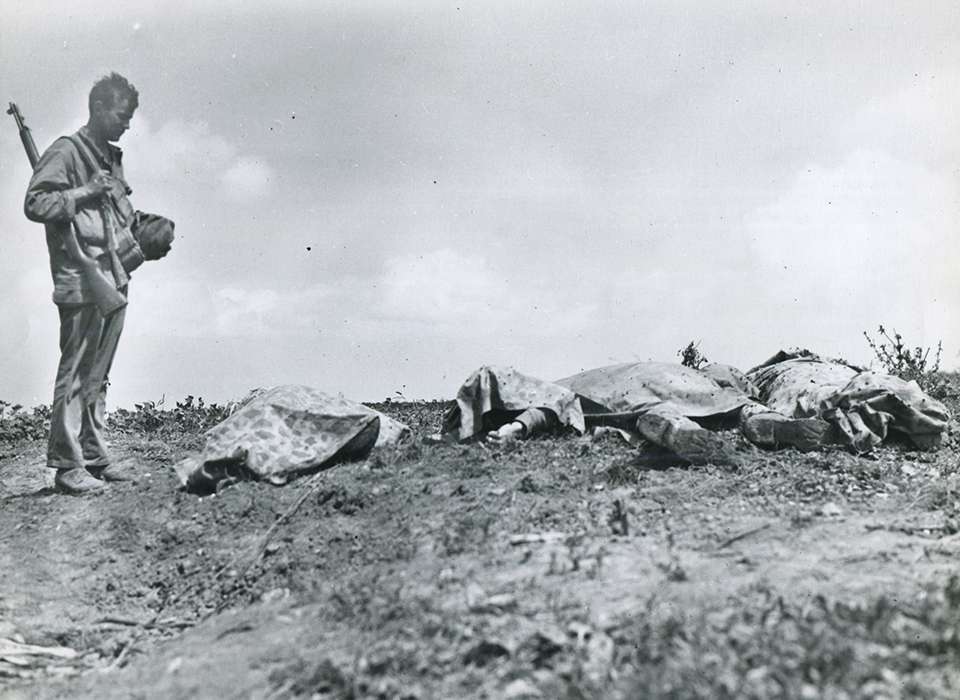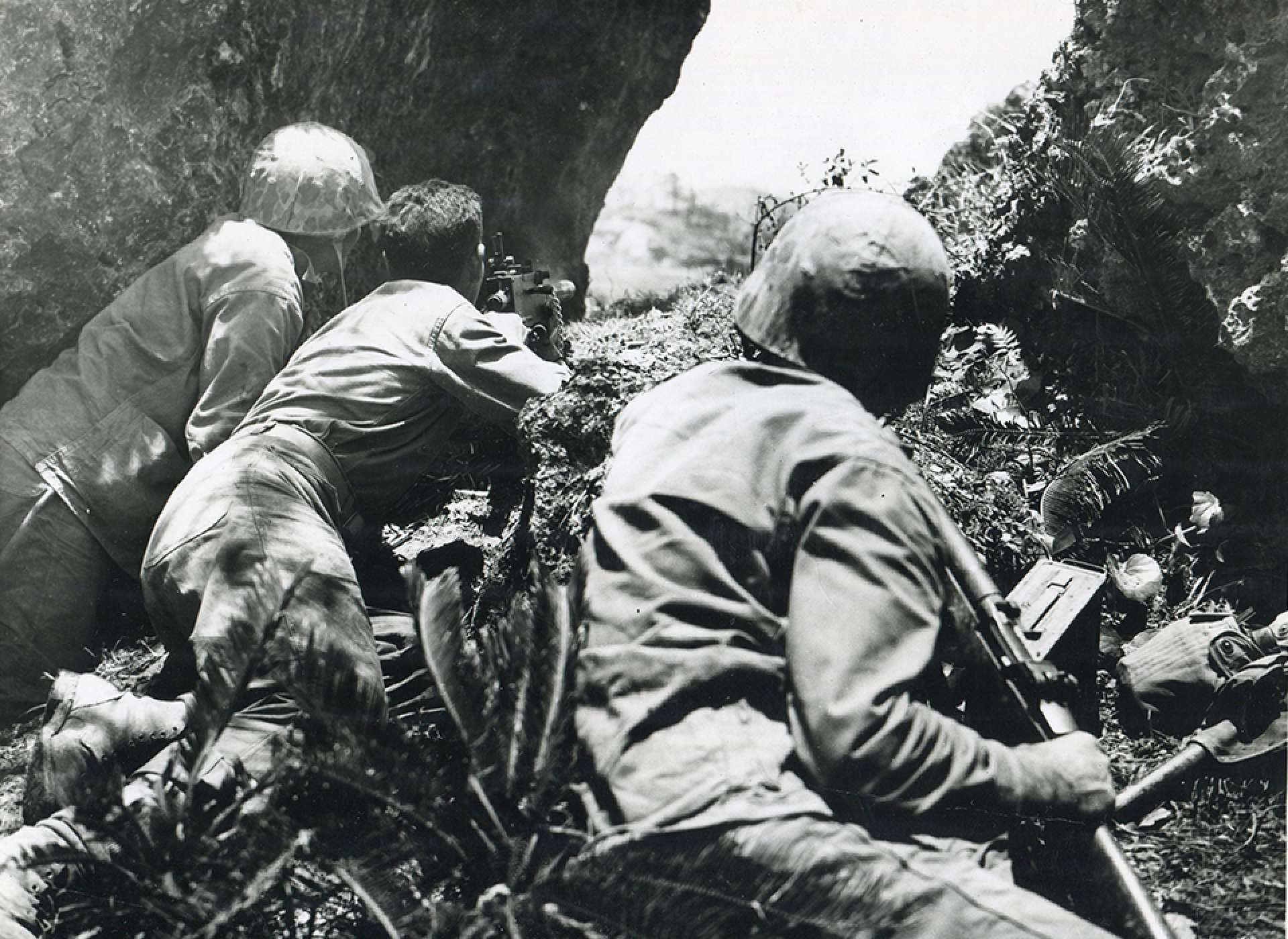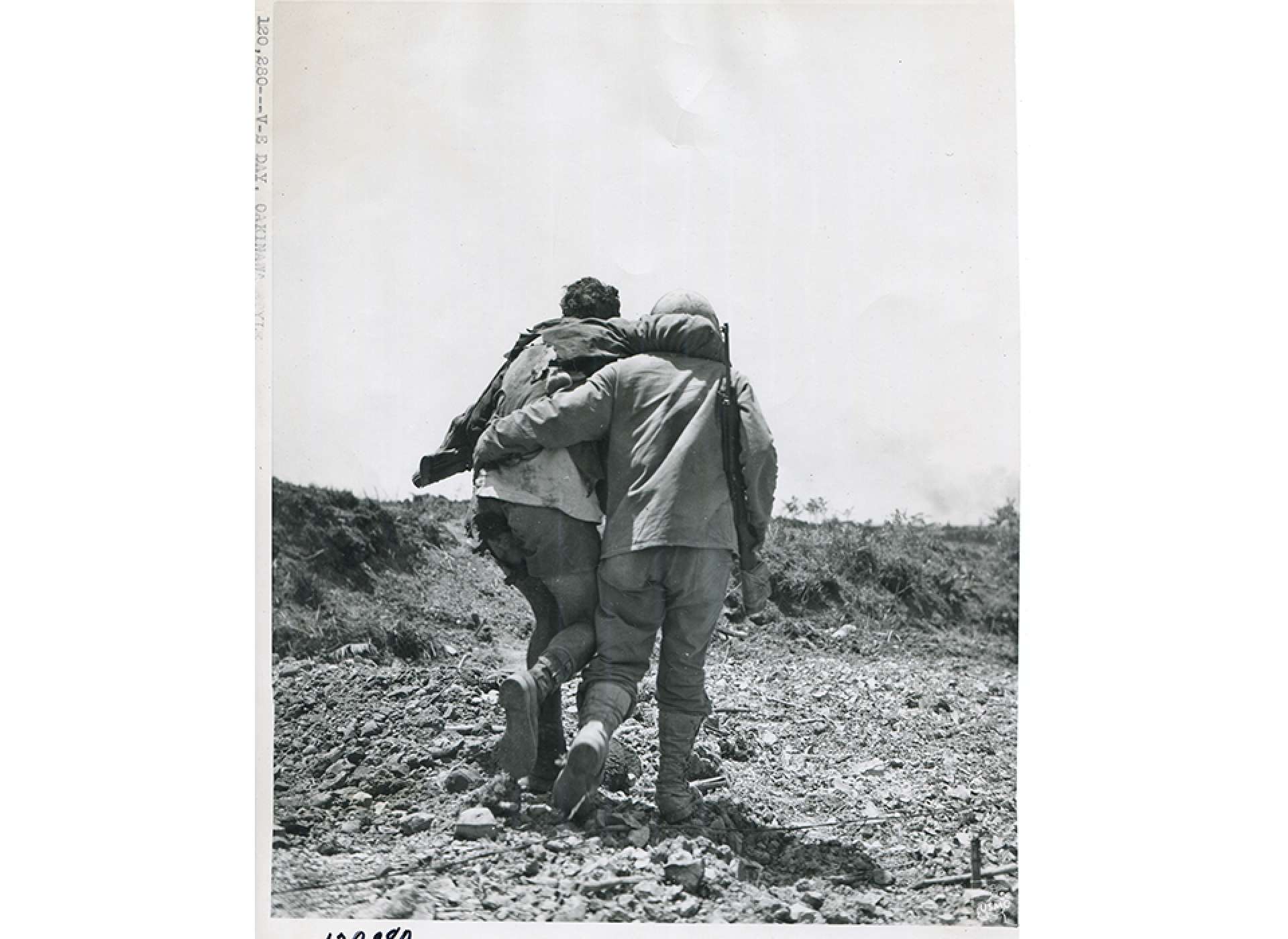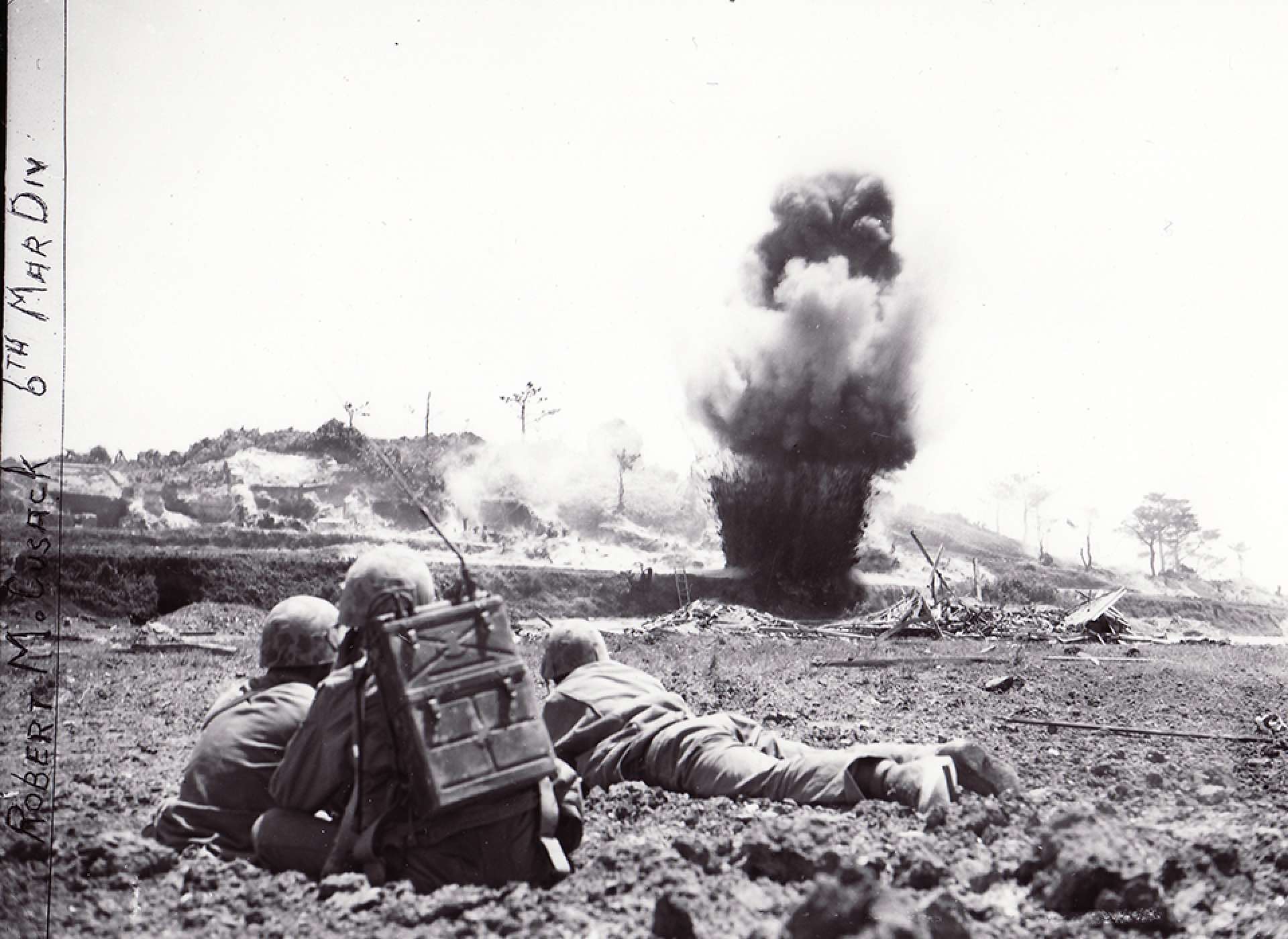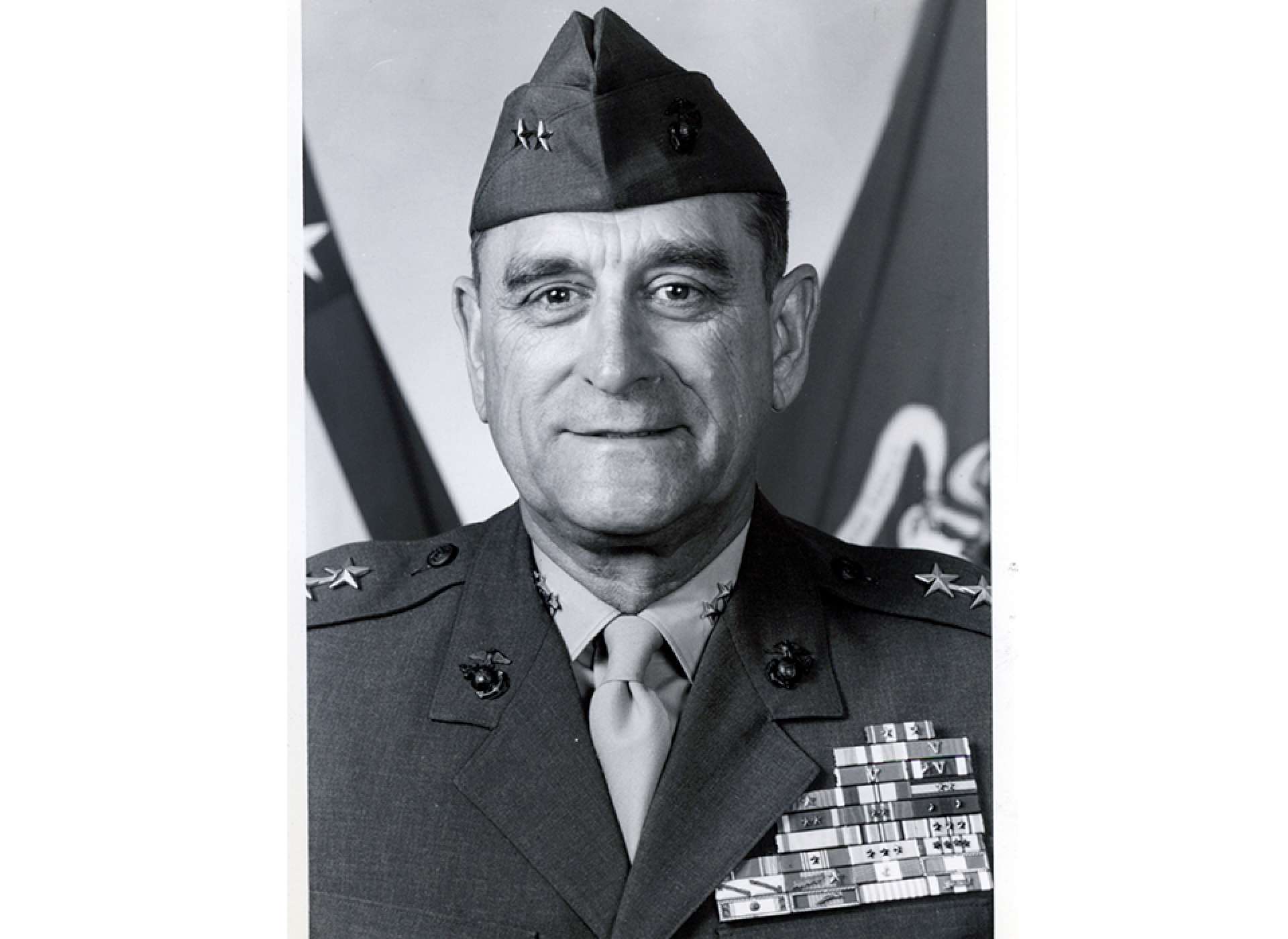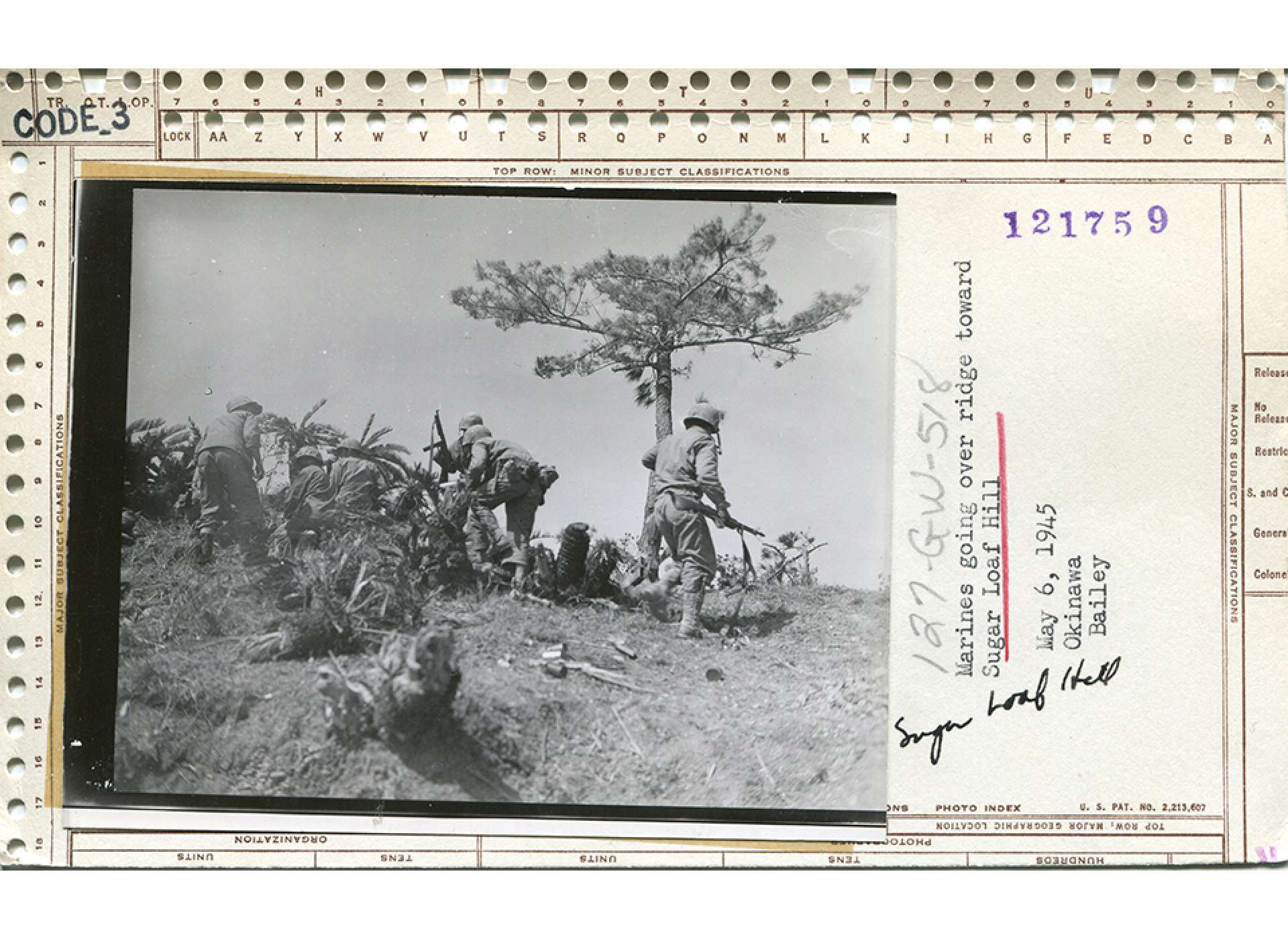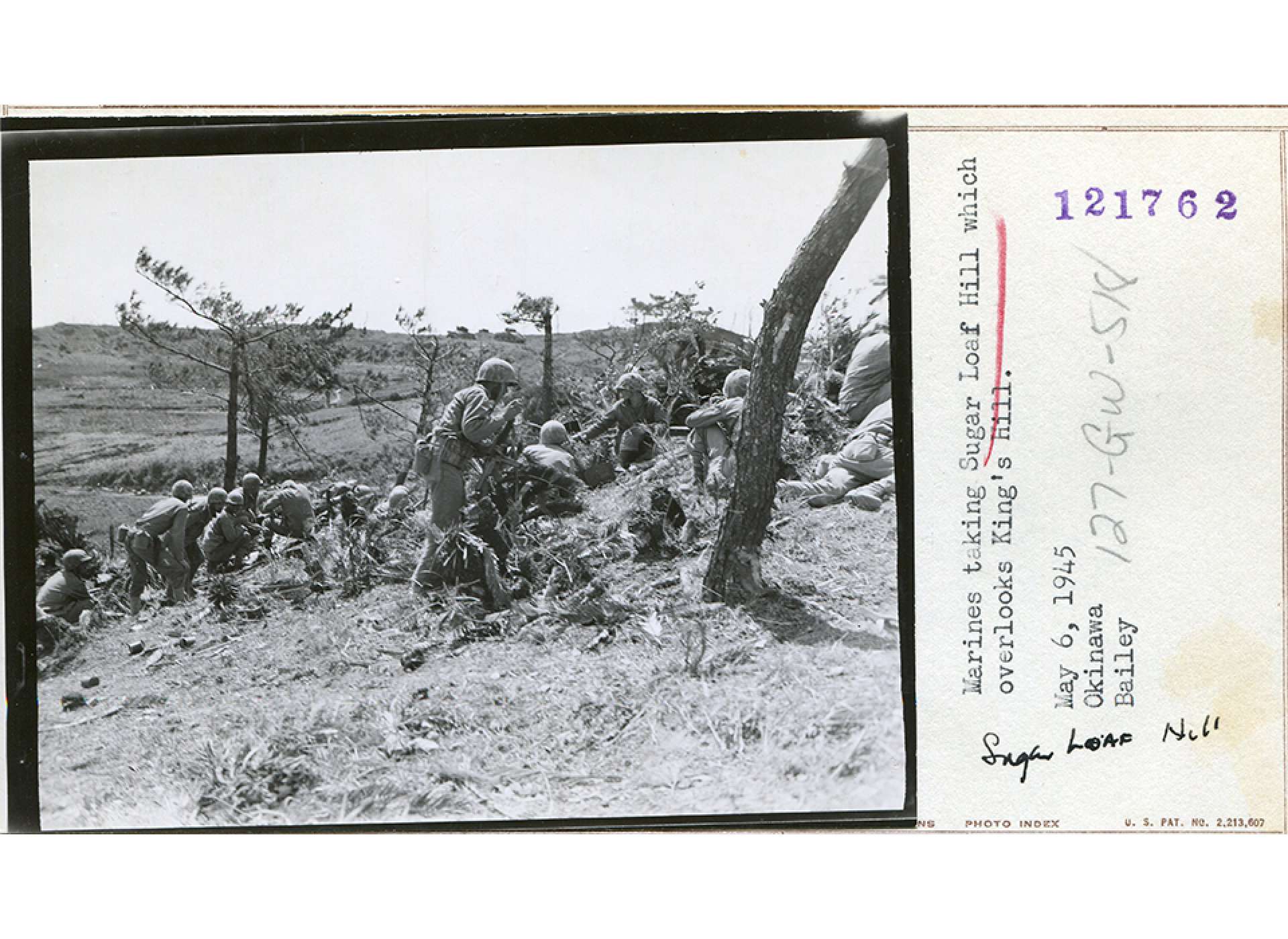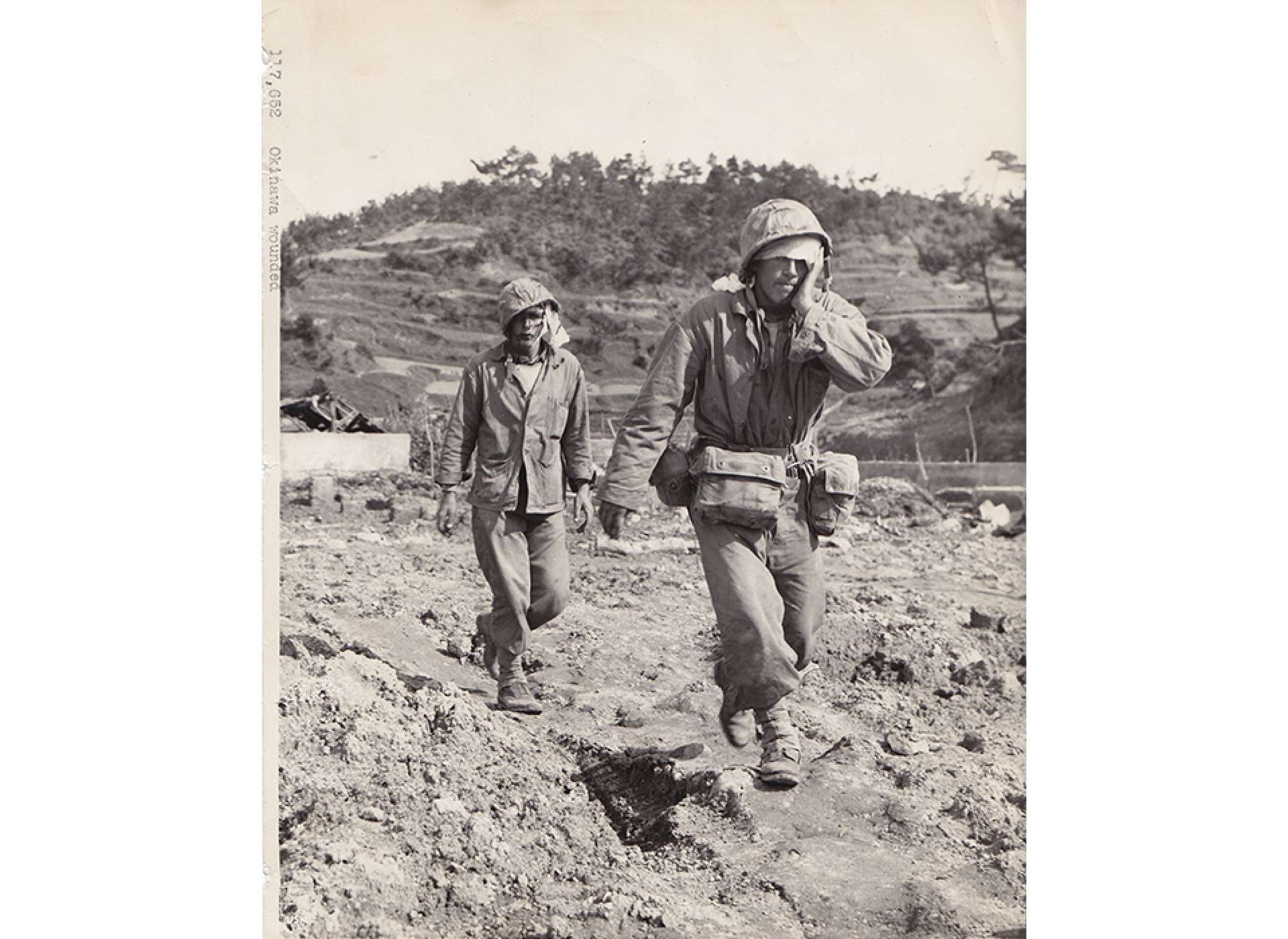The 6th Marine Division was the newest of all of the combat units on Okinawa in April 1945. Formed overseas in the Solomons in 1944, the only Marine Corps division to do so, the 6th was not considered to be a virgin combat unit despite the fact that it was brand new. Populated with veterans, as well as green troops, the 6th was untested as a unit, but filled with combat experience. The 1st Provisional Marine Brigade, around which the division was built, were veterans of the campaign for Guam. Still other combat veterans, including many former 4th Marine Raider Battalion veterans, filled the unit’s ranks. These veterans poured their hard-earned combat experience into the new troops before landing on Okinawa. So it was, that after the unit received their baptism of fire near the Motobu Peninsula in April, and moved with such rapidity that it earned even the Army’s praise, the newly blooded unit turned south to relieve the battered 27th Infantry Division that had worn itself to a frazzle at Kakazu Ridge earlier in the month.
The 6th slipped into the lines in early May alongside their brothers in the 1st Marine Division, on the “Old Breed’s” left flank, and pushed south preparing to attack the Shuri Line. In front of the 6th Marine Division lay a small complex of hills; three, to be exact. These three hills were part of a Japanese defensive complex that overlooked the open country that led straight up to the Japanese main line of resistance near Shuri Castle, and as such, formed the western anchor of the Shuri Line. Important territory for sure.
The first of these three hills was an unassuming little piece of high ground. Frankly, it wasn’t even that high of a piece of high ground. The crest of the hill, according to topographical maps, rose to a height of 230 feet. However, when compared to the surrounding ridges and territory, the crest of the hill actually only rose about 50 feet above the northern approaches to its slopes. The hill in question was codenamed Sugar Loaf by the Marines, and the other two small low hills that were a part of the defense complex were codenamed Half-Moon and Horseshoe. The unassuming little hills did not appear to be anything more than a bump in the road to the Marines who lay in their positions on the morning of May 12. To the men in the 22nd Marine Regiment, all three were just another objective, something to roll over, a quick objective to take in a day or less. Eight days later they would find out how wrong their assumptions had been.
While the defensive complex was no Mount Suribachi in terms of height or territorial observation, it was honeycombed with enemy positions. Any one of the three hills could be defended by any of the others. Interlocking fields of fire from each hill protected the slopes and approaches of the others. Pre-registered artillery spots had been gridded all over Sugar Loaf’s terrain, allowing any step by Marines to come under withering artillery fire. Machine gun positions that the Marines had never seen before lined Half-Moon and Horseshoe, while the real beast, Sugar Loaf, was pock marked with concrete reverse slope positions that would have to be eliminated one by one—by hand. Inside those positions were defenders that numbered just shy under an entire regiment, all interconnected by tunnels to reinforce any position that would potentially come under attack.
On the afternoon of May 12, the 22nd Regiment’s 2nd Battalion, Company G under the command of Captain Owen Stebbins kicked off the assault against the Sugar Loaf complex. As Stebbins’ Marines advanced across the flat land and headed up Sugar Loaf’s approaches, they received minimal gunfire and a smattering of artillery. The Marines advanced confidently towards the hill, making an advance of over 900 yards in short time.
As Stebbins’ Marines began to move up Sugar Loaf’s slopes, a rain of artillery and machine gun fire met the Marines, pinning down two of the three platoons in Stebbins’ company. Stebbins realized his position and assumed that reaching the top of the hill would help to eliminate the positions firing on him and his men. He rallied 40 of his men nearby, including Lieutenant Dale Bair, and raced up the slopes and into withering enemy fire. Half-way up the hill Stebbins was riddled with machinegun fire through his legs. Collapsing to the ground, surrounded by 28 of his wounded Marines, he ordered Lieutenant Bair to assume command and finish the assault with what men he had left. Before Bair could acknowledge his orders, his arm was shredded by machinegun fire. In a semi-conscious state, Bair was pulled back down the slopes of the hill. As he came to, he saw what was left of his company under tremendous fire, his men dropping like flies.
Despite the intense pain in his shredded arm, Bair got off of the stretcher, grabbed a weapon, and headed back up the hill to his Marines. As he went up the hill, he began firing at suspected Japanese positions to give his Marines cover. The closer he got to his company, the heavier the fire. Hit again by enemy fire, Bair reached a position in which there was a machinegun. Bair grabbed the weapon with his one good hand and raced up the hill, the remaining 20 or so Marines following close behind. Bair and his Marines reached the top of the hill, but took tremendous fire. With total disregard for his own safety, Bair stood on the crest of the hill, alone, and fired the machinegun with his one good hand to aid his men retreating down the hill with a smoke screen until he was hit repeatedly by enemy fire. Because of Bair’s actions, the Marines began to crawl down Sugar Loaf’s slopes, dragging their wounded, including Stebbins and Bair, down with them.
The initial assault had failed, and unfortunately for the 6th Marine Division, it was only the first of many failed attempts at capturing that “Goddamned little hill."
Company G charged up Sugar Loaf three more times that day, only to be chased off by deadly Japanese fire every single time. By nightfall on May 12, Company G was down to only 75 men, after having started the day with 215 in the company. Attacks against Sugar Loaf continued the following day, with Marines from the 22nd Regiment reaching its summit three times, only to be driven off three times, sustaining heavy casualties from Japanese artillery behind Half-Moon and Horseshoe, as well as machinegun fire from Horseshoe and Sugar Loaf each time they attacked. After each Marine assault, only the dead and dying remained on Sugar Loaf…all except one depleted squad.
Corporal James Day, a squad leader in the 22nd Marines had been issued orders to lead his squad up the slopes during one of Company G’s ill-fated attempts to take the hill on May 12. He did as he was ordered and led his men up the hill to add to the firepower that was so desperately needed. Day led his squad in a vicious attack that drew heavy mortar and artillery fire and a counterattack by about 40 Japanese. The Marines killed the enemy soldiers to a man during the counterattack, and held their ground until ordered to withdraw because of lack of available support.
The following day, Major Henry Courtney ordered Day and his squad to accompany him on a recon mission around Sugar Loaf’s slopes to meet the 29th Marines. Upon reaching the 29th Marines, Courtney ordered Day’s squad to accompany the 29th's Fox Company in their assault the next morning. Much like Company G the day before, Fox Company’s assault failed and they sustained heavy casualties. Day’s squad was down to seven men after Fox Company’s failed assault, and by evening, Day was cut off with his men in a shell hole on the opposite shoulder of the hill.
During the night, Corporal Day and his Marines could hear an assault taking place on the opposite side of the hill. During the assault, Day and his Marines opened fire on the Japanese from their position, diverting some of the Japanese away from the main Marine assault. The small depleted squad beat back three Japanese night assaults on their position with grenades, bayonets and bare fists. Five of Day’s men were wounded in the Japanese assaults, and fearing that they would die without medical attention, he brought each one down the hill by himself to the aid station behind the lines. When the Corporal reached his position on the slope of the hill again, his squad was down to only himself and two other Marines.
-

6th Division Marines open fire with 1919A1 machine gun near Sugar Loaf Hill.
-

A Marine helps his buddy wounded by Japanese artillery fire to the aid station.
-

Artillery fire falls in front of Sugar Loaf Hill.
-

Major General James Day (POSTWAR).
-

Marines going over the ridge toward Sugar Loaf Hill.
-

Marines taking Sugar Loaf Hill which overlooks King's Hill.
-

Two Marines, wounded in the fight for Sugar Loaf head to the aid station.
The next morning, May 15, the three Marines watched another Marine assault form up and attack. Day and his Marines opened fire on two columns of Japanese infantry who were making their way to attack the advanced Marine guard. Day and his Marines’ attack broke up the small Japanese column, but failed to stop the ultimate Japanese counterattack that pushed the Marines off the hill yet again. Realizing that his position was in desperate need of an automatic weapon, the seemingly fearless Corporal ran out of his hole and grabbed a discarded 1919A1 machinegun. As he gave the weapon to one of the two Marines in his hole, a Japanese mortar round exploded on the edge of the hole, killing one of his men and destroying the weapon. This left only Day and one squad member, PFC Dale Bertoli, with a rifle each alone on Sugar Loaf.
By the night of May 15-16, the presence of Day and Bertoli was well known to the Japanese. Persistent machinegun and rifle fire, as well as fairly accurate mortar fire gave Day and Bertoli a sleepless night. Throughout the night, the Japanese tried to get to Day and Bertoli, but because of the steep slope on Day’s side of the hill, he could hear the Japanese as they scrambled up to his position all night long, giving him and Bertoli time to react as the Japanese approached. As the enemy approached, Day and Bertoli would roll grenades down on them. The Japanese who survived the grenade barrages ran back down the hill, only to be backlit by their own flares, allowing the two Marines to shoot them as they ran away.
All through the next 24 hours, Day and Bertoli kept up their firing on any Japanese patrols or reinforcements that came into their view. In response, the Japanese kept sending night assaults at the two Marines, who in turn, kept killing the infiltrators. The pitch battle between the two Marines and the Japanese went on for another evening until a runner from the 29th Marines finally reached the two-man killing crew. Ordered to “get the hell out," Day and Bertoli abandoned their position of four days, leaving over 100 dead Japanese behind them.
As the two Marines retreated back to their own lines, a thundering artillery barrage of both Marine artillery and naval gunfire crashed down on Sugar Loaf. As the barrage lifted, Marine and Navy aircraft screamed in, dropping napalm across the shell scarred terrain in an attempt to kill and scatter what remained of the Japanese on and around the hill.
Following on the heels of the barrages was Easy Company 2nd Battalion 29th Marines. Four assaults by Easy Company achieved the same results as other units before. The company got to the top, held it against two vicious counterattacks that broke down to hand to hand combat, but finally had to withdraw, having lost over 150 Marines in the brutal fight.
On May 18, Dog Company of the 2nd Battalion 29th Marines attacked Sugar Loaf, this time with well-coordinated tank support. As the Marines went up the hill, the tanks poured through a gap in the Japanese defensive line just to the south. When the Marines got to the top of the hill, the Japanese ran out of their defensive positions for a counterattack, only to be met by tank and machinegun fire, much to their astonishment. The tanks mowed down the attacking Japanese, allowing Dog Company to be the first Marine unit to take and hold Sugar Loaf. The Marines would not relinquish the ground again.
The 22nd and 29th Marines had been shot to pieces attacking Sugar Loaf, forcing the commitment of the divisional reserve of the 4th Marines. The fresh unit moved into the lines, taking over defense of Sugar Loaf and simultaneously attacking Half-Moon and Horseshoe, seizing large portions of both the flanking hills. The night of May 19 saw a massive Japanese counterattack, over 700 men, throw themselves against the 4th Marine lines and be cut to pieces by small arms fire and incredibly accurate Marine artillery. As the sun rose the following morning, instead of withstanding another Japanese counterattack, the field of battle, already littered with row upon row of enemy dead, fell silent. The battle for Sugar Loaf Hill was finally over.
The fight for the seemingly insignificant little hill had cost the 6th Marine Division over 3,000 casualties. An untold number of Japanese were killed in, on and around the defensive complex of Half-Moon, Horseshoe, and Sugar Loaf. With the ground now taken, the 6th Marine Division moved further south alongside the 1st Marine Division who had broken through Wana, as well as the Army, who had seized Conical Hill. The following day, the “Old Breed” seized Shuri Castle, effectively eliminating the Japanese defensive line around Shuri.
Eight more miles, thousands more lives, and another month of misery would be spent in the fight ashore for Okinawa, but the Japanese defensive back had been broken at the Shuri Line. Mopping up would continue until June 21, when the Marines raised the Stars and Stripes over conquered territory for the last time in the Second World War. The fight ashore had cost the Americans dearly. Over 4,600 soldiers were killed on Okinawa, while the Marines lost a further 2,900 in combat. Exact figures on Japanese battle deaths are not known. It is estimated that over 110,000 Japanese were killed on Okinawa, and a further 140,000 Okinawan civilians were killed, either by suicide, illness, or utilization as human shields by attacking Japanese infantry. The bloodbath ashore on Okinawa alarmed new American President Harry S. Truman. So much so, that in order to avoid the same, or worse, results in an invasion of Japan, a new and terrible weapon would be used in order to force the Japanese to finally surrender.
In 1998, over 50 years after his epic fight on Okinawa, then retired Major General James L. Day would receive the Medal of Honor from President Bill Clinton for his leadership and repeated acts of valor atop Sugar Loaf. Day retired from the Corps after 43 years of service, having fought in World War II, Korea, and Vietnam. Among his awards for valor were the Medal of Honor, three Silver Stars, Bronze Star with “V” for valor, two Purple Hearts, and the Navy and Marine Corps Commendation Medal with Combat “V." The old warrior passed away nine months after having been awarded his country’s highest award for gallantry.
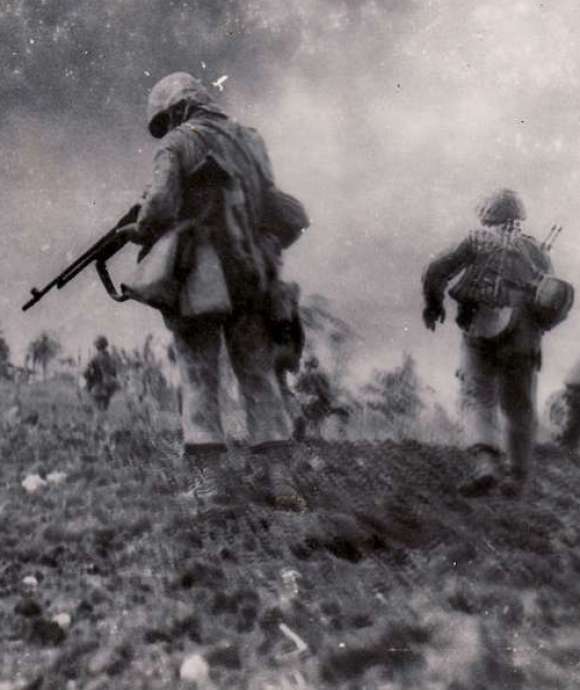
The Invasion of Okinawa: One Damned Ridge After Another
As Marines behind the lines ran supplies up to the grunts in the front, one survivor of the night action and a veteran of Peleliu was heard to tell his foxhole buddy about the upcoming fight, “This right here…well…this is gonna be a bitch.” He had no idea how accurate his prophecy would be.
This article is part of an ongoing series commemorating the 75th anniversary of the end of World War II made possible by Bank of America.
Seth Paridon
Seth Paridon was a staff historian at The National WWII Museum from 2005 to 2020. He began his career conducting oral histories and research for HBO’s miniseries The Pacific and holds the distinction of being the first historian hired by the Museum’s Research Department. In the 12 years he was Manager of Research Services, Seth and his team increased the oral history collection from 25 to nearly 5,000 oral histories.
Cite this article:
MLA Citation:
APA Citation:
Chicago Style Citation:
